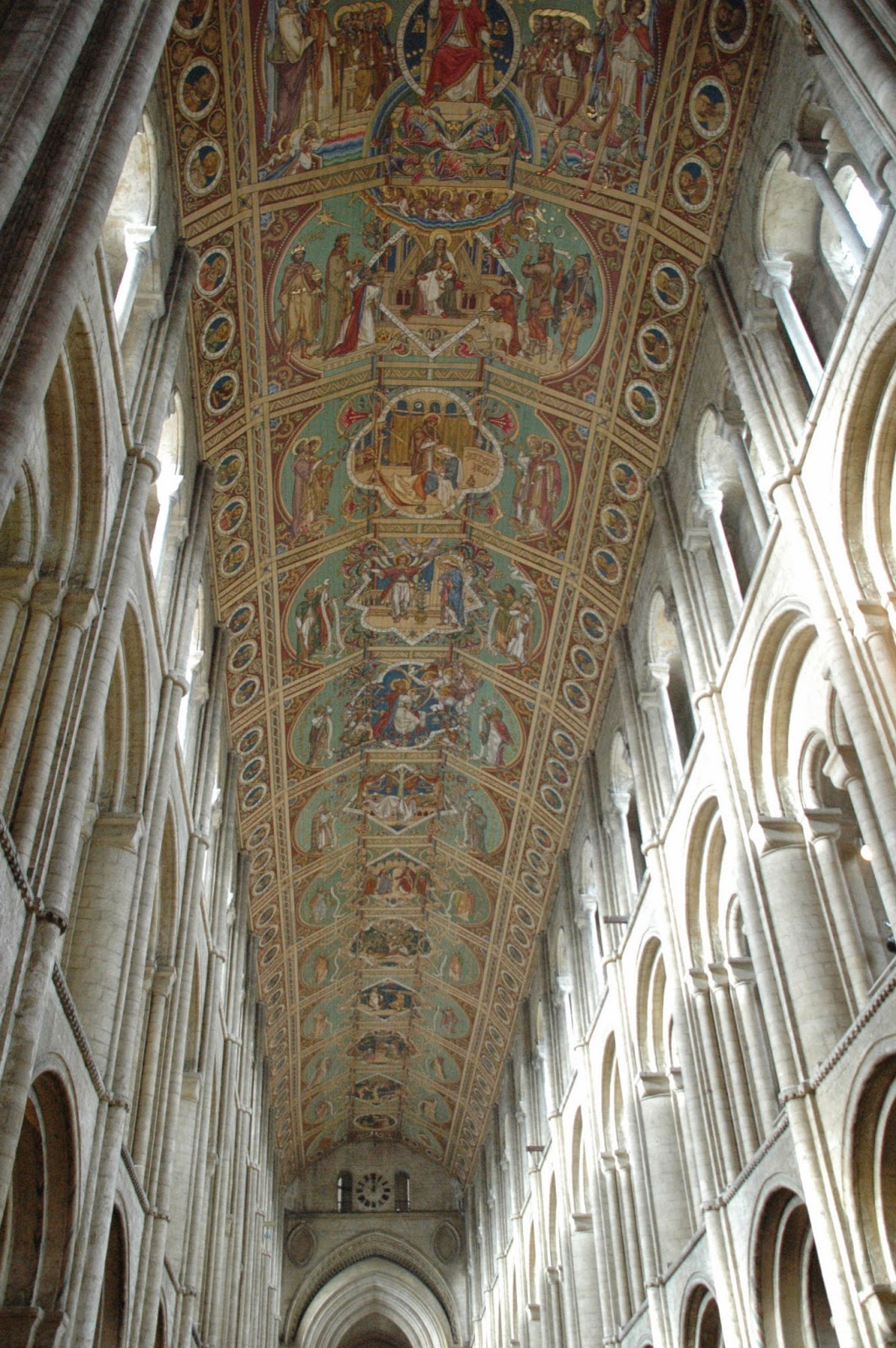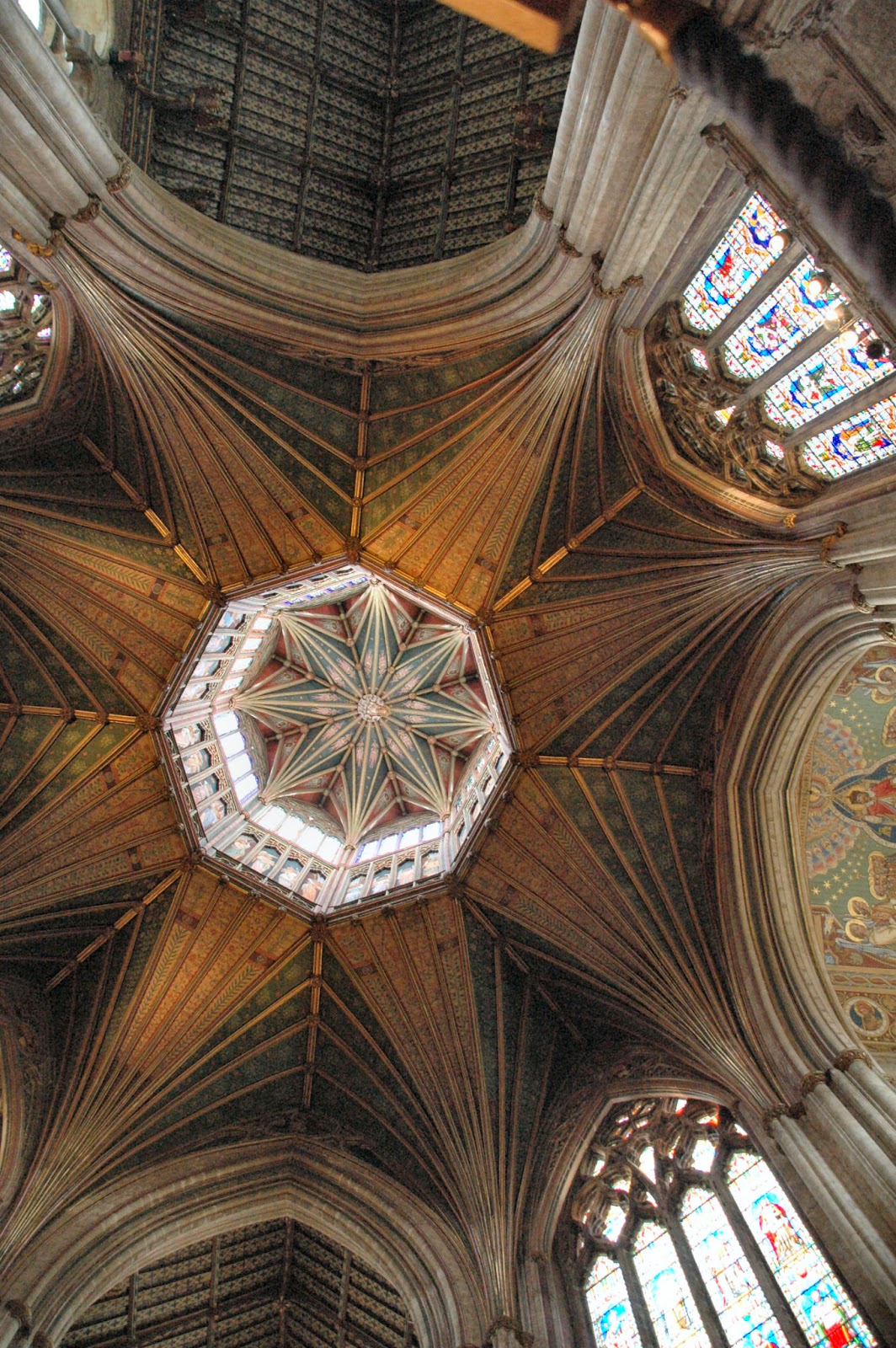Today we were going up to Ely to look at the cathedral there. It is a companion in design to King's College Chapel, but a lot bigger!
We got to Ely — only about 12 miles north of Cambridge — and went shopping in a Tesco before looking for our parking for the day. We found the Cathedral Car Park, which is a free car park near the Cathedral (duh!) Talk about busy — the place was chokka! But the coach parking area was vacant, so we redefined ourselves as a coach and parked there! We walked to the cathedral. Talk about wow factor! We knew it was big, as we had seen it from miles away as we approached Ely, but when you get close up, it's just mind-blowing. It is built on the site of St Ethelreda's double monastery for men and women, dating back to 673, but which was destroyed by the Vikings in 869. The current building was begun as an abbey in 1081, became a cathedral in 1109, but was not completed until 1189. It has dominated the landscape ever since.
Walked around, taking photos and just enjoying the cathedral, its associated Lady Chapel (a separate building to the side, now joined to the main cathedral by a modern Processional Way. The most striking things about the cathedral are the Victorian painted ceiling of the nave, whose first 8 sections depict the ancestry of Jesus, from Adam and down through Abraham, Jacob and David. The last four sections are New Testament: The Annunciation, the Nativity, the Adoration of the Magi, and Christ in Majesty. The roundels around the edge (84 in all) depict the ancestors of Jesus as given in Luke. The ceiling was completed in time for Christmas 1864.
Another highlight (in every sense) is the Octagon, a tower above the meeting point of nave, transepts and choir. Its lantern is filled with stained glass, and the painted panels below it are filled with angels. This octagon is supported above a timber fan vaulted ceiling, very reminiscent of the stone fan-vaulting in King's College Chapel.
And the organ is magnificent. And we haven't yet mentioned the stained glass, which is some of the best and richest in colour that we have seen. Just so you can see what we mean, we offer you the Noah window, just one of the many. All in all, a most pleasing visit.
The Lady Chapel, separate and to the north of the Presbytery, is the largest attached to any British cathedral, is just the shell of its original self, but there is a new altar in there, quite modern.
Another surprise is that in one of the side chapels Warren found niches with the relics of seven Anglo-Saxon saints. One of these was Bryhtnoth, who features in the Old English poem fragment The Battle of Maldon, and Wulfstan (died 1023), the Archbishop of York who is famous for one of his exhortative homilies, Sermo Lupi ad Anglos (The Sermon of the Wolf to the English, written in Old English, and blaming the fall of the English from the ways of the Church for the Viking raids then afflicting them.) Both of these works Warren studied in his Old English years.
The Lady Chapel, separate and to the north of the Presbytery, is the largest attached to any British cathedral, is just the shell of its original self, but there is a new altar in there, quite modern.
Another surprise is that in one of the side chapels Warren found niches with the relics of seven Anglo-Saxon saints. One of these was Bryhtnoth, who features in the Old English poem fragment The Battle of Maldon, and Wulfstan (died 1023), the Archbishop of York who is famous for one of his exhortative homilies, Sermo Lupi ad Anglos (The Sermon of the Wolf to the English, written in Old English, and blaming the fall of the English from the ways of the Church for the Viking raids then afflicting them.) Both of these works Warren studied in his Old English years.
On our way back to Cambridge, we called in to Denny Abbey and Farmland Museum. This is partially an English Heritage site, but the museum is independent. Although we weren't much interested in the museum, we paid for entry as a form of donation! The Abbey is a weird site — originally, from 1159, an offshoot, or dependent 'cell', of Ely Cathedral Priory, it was successively occupied by Benedictine monks, the Knights Templar, and the Poor Clares (an order of Franciscan Nuns). With its closure by — you guessed it — Henry VIII, in 1539, it became a farm, until the abbey was taken over by English Heritage in the 1960s, and the locals set up the associated museum.
We then went back to our layby outside Cambridge, where we found that the camera had played up again, and virtually all the shots of Ely had gone AWOL. But Warren has now realised that it was in part user error, prompted by an original glitch in the camera. In future, instead of just ejecting and reseating the flash card when it is not recognised by the camera (which happens from time to time), he will first turn the camera off before this process — trying to eject the card with the camera on is fraught with danger! So we have decided to revisit Ely tomorrow — it's not far away.
Distance driven — today, 47 miles ( 75 km ); to date, 9,451 miles ( 15,210 km )

















No comments:
Post a Comment